Hydrogen Energy
Hydrogen Energy Equipment Manufacturing and Hydrogen Energy Innovation Research Institute Project of Jilin City
1. Introduction to the Project
1.1 Project background
1.1.1 Product introduction
This project plans to construct production plants and hydrogen energy cell production equipment, mainly producing high-power hydrogen fuel cell power generation systems, high-power hydrogen fuel cell power systems and core components, as well as research and development (R&D) and experimental equipment, and testing equipment of cutting-edge innovative technology, etc.
The hydrogen fuel cell power generation system consists of a hydrogen input subsystem, a fuel cell subsystem, an electrical output subsystem, and a control and protection subsystem. The hydrogen input subsystem is responsible for the storage and transportation of hydrogen; The fuel cell subsystem makes hydrogen react with oxygen to generate electric energy; The electrical output subsystem provides the generated electric energy for external loading; The control and protection subsystem ensures safe and stable operation of the system. It is mainly used as backup power supply in key places such as communities, medical facilities, communication, and data centers; It is combined with solar, wind and other renewable energy sources to build hybrid micro-grid system, etc.
The high-power hydrogen fuel cell power system consists of multiple individual cells, each containing an anode, a cathode, and a proton exchange membrane. The anode is the site where hydrogen fuel undergoes oxidation, the cathode is the site where oxidants are reduced, and both poles contain catalysts that accelerate electrochemical reaction of electrodes. The proton exchange membrane serves as the electrolyte. It is mainly used in vehicle power system, backup power sources for communication base stations, unmanned aerial vehicle (UAV) power systems, and energy storage power stations, etc.
1.1.2 Market prospect
(1) Analysis of the current market situation of hydrogen energy
Hydrogen, as one of the most important elements on Earth, mainly exists in its chemical form. Its elemental form, hydrogen (H2), is a clean and efficient energy carrier. In recent years, with the increasing global demand for clean energy, hydrogen and its related technologies have received widespread attention. Especially in the context of carbon peaking and carbon neutrality, hydrogen, as a secondary clean energy, is regarded as the “Ultimate Energy of the 21st Century”.
In recent years, China’s hydrogen energy industry has received high attention from governments at all levels and key support from national industrial policies. According to statistics, in 2024, a total of 22 provincial-level administrative regions in China included hydrogen energy in their government work reports, and each region actively developed hydrogen energy from different focuses. Since 2024, China has issued a large number of policies at the national level in the hydrogen energy industry, covering many aspects such as industry standard setting, technology R&D, equipment promotion, urban public transportation updates, and hydrogen energy transportation, aiming to promote the healthy, orderly, and sustainable development of the hydrogen energy industry.
Under the dual promotion of policies and market, China has become the world’s largest country of hydrogen production. As of the end of 2023, the national hydrogen production capacity has been about 49 million tons/year, with an output of about 35 million tons, an increase of about 2.3% year-on-year. In 2024, China’s hydrogen output is reached 36.95 million tons.
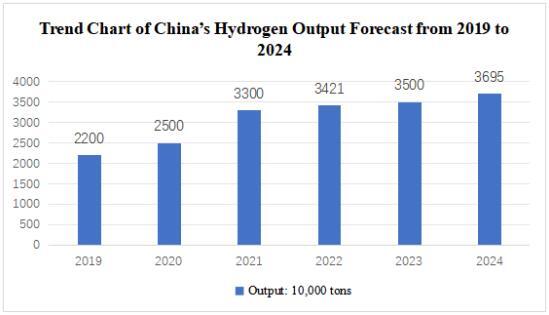
Figure 1 Trend Chart of China’s Hydrogen Output Forecast
Under the goal of carbon neutrality, the annual demand for hydrogen in China will have reached 37.15 million tons by 2030, accounting for about 5% of terminal energy consumption. By 2060, the annual demand for hydrogen in China will have increased to around 130 million tons, accounting for about 20% of terminal energy consumption. Among them, the hydrogen consumption in the industrial field still accounts for the largest proportion, accounting for 60% of the total demand.
(2) Current market development situation of hydrogen energy cells
Thanks to technological advancement, policy support, and increasing market demand, the market size of China’s hydrogen fuel cell industry has grown rapidly. The market size of China’s hydrogen fuel cell industry (in terms of sales) has increased from 1.63 billion yuan in 2019 to 3.93 billion yuan in 2023, with a compound annual growth rate of 24.61%. The market size of hydrogen fuel cell system in China is reached 5.99 billion yuan in 2024.
In 2023, the total installed capacity of fuel cell systems for registered vehicles in China was 734 MW, with a year-on-year increase of 49.3%. From January to June 2024, the installed capacity exceeded 265 MW, with a year-on-year increase of 22.5%. The TOP 3 domestic manufacturers in terms of installed capacity of fuel cell systems are Sinohytec, Sinosynergy, and Refire.
Since 2024, many regions have introduced favorable policies for hydrogen vehicles, such as waiving highway tolls and lifting road rights restrictions, further reducing the full life-cycle cost of hydrogen vehicles and promoting their demonstration operation, resulting in a further increase in the number and scale of hydrogen vehicles. In 2023, the production and sales of hydrogen vehicles in China reached 5,668 and 5,791, respectively, with an increase of 56.3% and 72.0% year-on-year compared to the previous year, ranking among the top in the world. In the first half of 2024, the sales of hydrogen vehicles totaled 2,644, with a year-on-year increase of 9.7%, and the cumulative sales reached 20,742. Among them, hydrogen powered heavy-duty trucks accounted for about 50% of the sales, and became the main model for promotion, and came into demonstration operations especially in ports, industrial parks, mines and other scenarios.
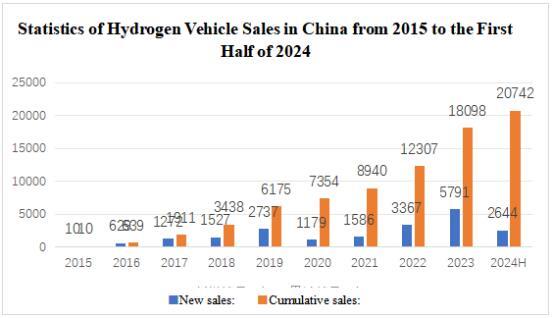
Figure 2 Statistics of Hydrogen Vehicle Sales in China
With the continuous increase in the number of fuel cell vehicles, the number of hydrogen refueling stations in China has significantly increased. As of the end of 2023, China has built 474 hydrogen refueling stations and 122 new stations, covering a total of 30 provinces (autonomous regions, municipalities, and special administrative regions). The number of hydrogen refueling stations built in China reached 569 by 2024.
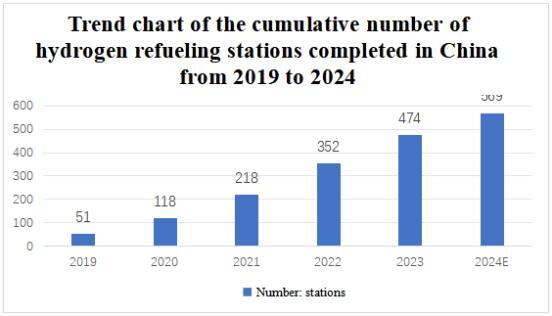
Figure 3 Statistical Table of the Number of Hydrogen Refueling Stations Completed in China
In recent years, the number and amount of financing events in the hydrogen energy industry have remained at a high level. In the first half of 2024, there were 15 hydrogen financing cases, with 4 cases exceeding 100 million yuan. For example, Zhejiang Chunqing Technology Co., Ltd. received a financing of US$ 100 million, and Shanghai Tai Hydrogen Energy Technology Co., Ltd. completed a Pre-A round financing of 150 million yuan.
(3) Analysis of the hydrogen energy market in Jilin province
Jilin Province is an important energy base in China, with superior energy resource endowment conditions, especially abundant renewable energy resources, which have laid a good resource foundation for the development of hydrogen energy. Under the “carbon peaking and carbon neutrality” goals, Jilin has also chosen the hydrogen energy industry as a key player in advancing towards the dual carbon goals.
In terms of hydrogen production equipment, the first 1,000 Nm³/h alkaline water electrolyzer in Jilin Province was launched in Taonan City. This equipment is a major breakthrough in the manufacturing of the equipment for hydrogen production from water electrolysis of renewable energy in Jilin Province, filling the gap in the research, design, and manufacturing of large standard cubic feet (scf) alkaline electrolyzers in Northeast China.
Alkaline water electrolyzer is currently the only equipment for hydrogen production from water electrolysis that meets large-scale engineering applications, with advantages such as mature technology and low cost. However, the PEM hydrogen production route is more suitable for renewable energy, with stability and reliability. The local enterprise Changchun Green Drive has successfully launched PEM electrolyzers with a single-cell rated hydrogen production of 400 Nm³/h PEM, leading the R&D capacity for large-scale PEM hydrogen production equipment in China to a new level.
In terms of integrated wind and photovoltaic (PV) hydrogen production project, in Songliao Clean Energy Base, one of the eight major clean energy bases, Jilin has a planned production capacity of nearly 4.5 million tons/year of green ammonia. By now, the scale of green hydrogen projects that have started construction in Jilin Province has reached 400,000 tons/year, accounting for almost 50% of the total project scale, with Songyuan and Da’an projects ranking first.
The largest green hydrogen-ammonia-alcohol integration project in Songyuan has begun construction, with a total planned annual production of 110,000 tons of green hydrogen and 600,000 tons of green ammonia/alcohol, mainly targeting overseas markets. The CEEC Songyuan Hydrogen Energy Industrial Park Project produces green hydrogen from local wind electricity and PV, and then synthesizes ammonia and methanol from green hydrogen.
The Green Hydrogen Production and Ammonia Synthesis from Wind and PV Integration Project of Da’an has started construction comprehensively, achieving large-scale application of domestic and independent hydrogen production equipment. The Da’an Project produces green hydrogen from green electricity and then synthesizes green ammonia, stores liquid ammonia in spherical tanks, and finally sells it.
In the field of transportation, FAW Group’s emphasis on hydrogen fuel cell vehicles represents Jilin’s achievements in the hydrogen fuel cell industrial chain to some extent. In 2022, 300 hydrogen fuel cell vehicles from FAW Jiefang were launched and sent to Beijing, Shanghai, and Shanxi, marking that FAW Jiefang’s hydrogen energy commercial vehicles entered the commercial landing stage gradually.
At the 2023 China Commercial Vehicles Show (CCVS), FAW Jiefang’s “Xingyi” hydrogen energy heavy-duty truck made a big debut. Equipped with a 300 kW fuel cell system and a 70 Mpa hydrogen storage system, it can achieve an ultra-long range of 1,200 km. In addition, FAW Jiefang is gradually planning to build an exclusive base for fuel cell vehicles and system, with a hydrogen energy industry cluster as its characteristic.
Overall, as an important industrial base in China, Jilin is gradually breaking free from the shackles of single industry development and seeking new economic growth points. By now, as the National Development and Reform Commission (NDRC) clarifies the strategic position of hydrogen energy, Jilin is cultivating this emerging industry to empower the chemical industry and achieve low-carbon transformation.
The development of Jilin’s hydrogen energy industry cannot be separated from policy support. In recent years, in order to promote the development of the hydrogen energy industry, the Jilin Provincial Government has first formulated a medium - and long-term development plan for the hydrogen energy industry, clarifying the focus of medium - and short-term development. Subsequently, it has continuously introduced a series of supportive policies to accelerate the comprehensive development of the hydrogen energy industrial chain.
In the Mid- and Long-term Development Plan of a Hydrogen-powered Jilin (2021-2035), Jilin proposes to lay out the hydrogen energy industry based on the “three-step” strategy, with “one zone, two axes, and four bases”, and create a “Hydrogen Valley in North China”. “One Zone” refers to a national-level demonstration zone for the integration of new energy and hydrogen energy industries within the region. “Two axes” refer to the “Baicheng-Changchun-Yanbian” and “Harbin-Changchun-Dalian” hydrogen energy corridors, with one horizontal and one vertical axis, forming a spatially interconnected hydrogen energy industrial chain and supply chain system in the three provinces of Northeast China. By 2025, the layout of the hydrogen energy industry will have taken shape, the industrial chain will have gradually improved, the industry scale will have grown rapidly, the output value of the hydrogen energy industry will have reached 10 billion yuan, and the installed capacity of new energy will have been driven by 5 million KW. By 2030, the hydrogen energy industry in the province will have achieved leapfrog development, the layout of the industrial chain will have become more perfect, industrial clusters will have formed a scale, and the output value will have reached 30 billion yuan.
Jilin Province will continue to promote the leapfrog growth of the hydrogen energy industry by taking the lead in transportation, making key breakthroughs in the chemical industry, developing independently in the equipment field, and demonstrating synergy in the energy field.
(4) Market prospect analysis of hydrogen energy
Hydrogen energy, as a green and low-carbon secondary energy, has a wide application prospect. By now, hydrogen energy is mainly used in fields such as energy storage, centralized/distributed power generation, hydrogen powered vehicles, hydrogen powered ships, hydrogen powered aviation, hydrogen metallurgy, and building heating. However, despite the wide range of applications of hydrogen energy, its market potential has not yet been fully unleashed. In the future, with the advancement of technology and the reduction of costs, hydrogen energy will be applied and developed in more fields. For example, hydrogen energy can be used as an important component of renewable energy to solve the storage problem of intermittent renewable energy; Hydrogen can also replace fossil fuels in the industrial field to achieve low-carbon production. Therefore, developing more hydrogen energy application scenarios will help promote the rapid development and widespread application of the hydrogen energy industry.
Overall, the National People’s Congress (NPC) and The Chinese People’s Political Consultative Conference (CPPCC) in 2024 emphasized the importance of new energy, and proposed to vigorously develop a green and low-carbon economy and promote the green transformation of industrial structure, energy structure, transportation structure, and urban and rural construction and development. The government work report points out that, we need to consolidate and expand the leading advantages of industries such as intelligent connected new energy vehicles, accelerate the development of cutting-edge emerging industries such as hydrogen energy, new materials, and innovative drugs, actively and steadily promote carbon peak and carbon neutrality, deepen the energy revolution, control fossil energy consumption, and accelerate the construction of a new energy system. Driven by the background of the “dual carbon” goal and the increasing demand for green electricity, the development of new energy is bound to usher in an explosive period. Compared to thermal power generation, which has a significant impact on the environment, green electricity such as solar energy, wind power, geothermal energy, biomass energy, and nuclear energy is more in line with the requirements for being environment-friendly and sustainable, and is the direction for future development.
1.1.3 Technical analysis
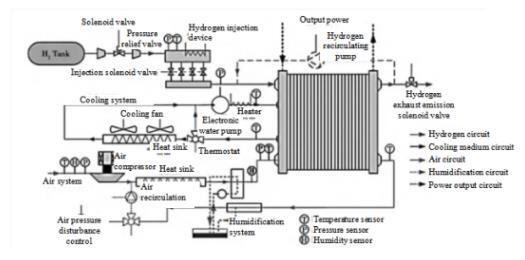
Figure 4 Process Flow Chart
Not limited to current technology, if the resident enterprise has innovative technology, the resident enterprise’s technology will be adopted, and this technical analysis is only for reference.
The fuel cell engine is the core component of fuel cell vehicles, which is a power generation device that directly converts fuel hydrogen and oxygen in the air into electric energy through electrochemical reactions. Its performance determines the overall operating efficiency, adaptability, safety performance, service life, and development cost of fuel cell vehicles. Therefore, it is of great significance to systematically review and analyze the technology and related components of fuel cell engines.
The power generation process of fuel cell engines does not involve thermal energy conversion, has no mechanical losses, has high energy conversion efficiency, runs smoothly and without noise, and only produces water as a byproduct. Therefore, it is called the “most ideal environment-friendly engine”. By now, the fuel cell engines used in fuel cell vehicles are all hydrogen fuel cell engine systems, mainly composed of fuel cell stack, air supply module, hydrogen supply module, heat dissipation module, and intelligent monitoring module coordinated with each other. The PID schematic diagram of the hydrogen fuel cell engine is shown in the above figure.
1.1.4 Advantageous conditions of project construction
(1) Policy advantages
In March 2022, the NDRC and the National Energy Administration (NEA) jointly released the Medium and Long-term Plan for Hydrogen Energy Industry Development (2021-2035), which proposed different development goals at different stages: by 2025, the core technology and manufacturing process will have been basically mastered, the number of fuel cell vehicles will have been about 50,000, a number of hydrogen refueling stations will have been deployed and constructed, the hydrogen production from renewable energy will have reached 100,000 to 200,000 tons/year, and the carbon dioxide emissions will have been reduced by 1 to 2 million tons/year; By 2030, a relatively complete hydrogen energy industry technology innovation system, clean energy hydrogen production and supply system will have been formed, which will effectively support the achievement of carbon peaking goal; By 2035, a diversified hydrogen energy application ecosystem will have been established, and the proportion of renewable energy hydrogen production in terminal energy consumption will have been significantly increased.
The Opinions of the Central Committee of the Communist Party of China and the State Council on Accelerating the Comprehensive Green Transformation of Economic and Social Development is the first systematic deployment at the central level to accelerate the comprehensive green transformation of economic and social development. The Opinions proposes to develop PV along highways according to local conditions in the field of hydrogen energy transportation, improve infrastructure networks such as charging piles, hydrogen refueling stations, and shore power, and accelerate the construction of urban smart transportation management systems. Improve the renewable energy standard system and industrial green low-carbon standard system in the formulation of hydrogen energy standards, and establish sound standards for “production, storage, transportation and use” of hydrogen energy.
The 14th Five-Year Plan for Industrial Development in Jilin Province clearly proposes to promote the development of hydrogen energy equipment and hydrogen fuel cells around the entire industrial chain of hydrogen “production, storage, transportation, refueling and utilization”. Support the RD of intelligent heat exchange units and new high-efficiency energy-saving heat exchangers. Accelerate the development of environment-friendly equipment such as air pollution control, water pollution control, and solid waste treatment. Cultivate new energy system solution suppliers, and establish RD and manufacturing bases of new energy equipment.
The Mid- and Long-term Development Plan of a Hydrogen-powered Jilin (2021-2035) proposes to make the hydrogen energy industry a key focus for cultivating and developing strategic emerging industries. Based on the chemical industry in Jilin City, Baicheng City, and Songyuan City, we should carry out demonstrations of “Green Chemical Industry in Jilin” (hydrogen-based chemical industry) projects, build diversified hydrogen energy supply, carbon fiber material and other industry auxiliary systems, and expand the business scope of the chemical industry.
(2) Resource advantages
Jilin City has great potential for the development of resources such as hydropower, wind energy, solar energy, biomass energy, and oil shale, etc. Jilin City has developed water systems and abundant hydropower resources, consisting of some sections and tributaries of the Songhua River, Lalin River, and Mudanjiang River systems. Its annual available water resources are 17 billion cubic meters, and the per capita water resources are 1.8 times the national average level and 5.4 times that of northern cities. It not only can fully develop hydropower projects, but also has the conditions to build large-scale pumped storage power stations. The equivalent full-load on grid hours of wind power in various regions mainly range from 2,000 hours to 3,300 hours. Jilin City is located in the central part of Jilin Province, with a total solar radiation of 4,800-5,000 MJ/㎡, and the radiation levels in various regions of the city are basically the same. The annual sunshine distribution is basically consistent with the distribution of solar radiation, with an average annual power generation hours of 1,320. Jilin City is an important grain production base in the province, with abundant resources of crop straw and forestry processing residues, and superior conditions for utilization of biomass energy. Among them, the annual output of agricultural straw resources is 6.53 million tons, and the annual output of forestry resources is 1.5 million tons, both of which can be used for the development of biomass energy. The Songhua River Basin has abundant water resources and stable regional seismic and engineering geological conditions, providing favorable conditions for the development of nuclear energy. In the early stage, nuclear power project sites have been selected in Liangjiashan, Shulan, Songjiang, Jiaohe, and Dianjiangtai, Huadian, and research has been conducted on promoting nuclear heating small reactor projects, having a certain foundation for the development of nuclear energy resources.
The installed capacity of power sources in the city is 10 million KW, with an additional 3.279 million KW added during the 14th Five-year Plan period, an average annual growth rate of 8.3%. Among them, coal-fired power generation is 3.07 million KW, accounting for 30.7%; Gas power generation is 860,000 KW, accounting for 8.6%; Wind power is 1.54 million KW, accounting for 15.4%; PV power generation is 700,000 KW, accounting for 7%; hydropower generation is 3.5 million KW (conventional hydropower generation of 3.2 million KW and pumped storage is 300,000 KW), accounting for 35%; biomass power generation is 270,000 KW, accounting for 2.7%; waste generation is 58,000 KW, accounting for 0.6%, while the installed capacity of new and renewable energy accounts for 60.7% of the total installed capacity. It is expected that by 2025, the power generation will have reached 20.63 billion kWh, and the total transformer capacity of urban and rural power grids will have reached 4891.1 MVA.
(3) Industrial advantages
Jilin City is an old industrial base city in Northeast China, known as the Cradle of the National Chemical Industry, The First Metallurgical Industrial Base, and The Mother of hydropower in the People’s Republic of China. It has contributed the first bag of fertilizer, the first bucket of dye, and the first furnace of calcium carbide to the country. In terms of the chemical industry, it has nearly a thousand sets of devices at chemical industrial scale or above, with 11 sets of devices for methyl isobutyl ketone and methyl methacrylate, etc. ranking among the top three in China in terms of production capacity. The construction of the 1.2 Million Tons Ethylene Transformation and Upgrading Project of Jilin Petrochemical is progressing in an orderly manner. This is the largest single investment industrial project in our province since the founding of the People’s Republic of China, and also the first chemical project of CNPC that uses all green electricity. In terms of carbon fiber industry, it has the only “National-level Carbon Fiber High-tech Industrialization Base” approved by the Ministry of Science and Technology of the People’s Republic of China, forming the most complete carbon fiber industrial chain in China from “acrylonitrile to acrylonitrile-based raw silk to carbon fiber to downstream products”. The raw silk production capacity ranks first in the world, while the carbon fiber production capacity ranks first in China and second in the world. In terms of metallurgical industry, it has the largest metallurgical base in the province, and 2 national metallurgical technology centers. Jianlong Group has become the first steel production enterprise in the province. In terms of energy industry, it has advantageous hydropower resources, and the Jiaohe Pumped Storage Power Station with a total investment of 7 billion yuan has been fully launched, marking the start of construction of China’s first 10 million kilowatt-level pumped storage base. Jilin City has abundant industries such as raw materials, with guaranteed supply of upstream materials and energy consumption, and certain advantages in price and transportation.
Jilin City and China Energy Engineering Corporation (CEEC) signed a Green Methanol and Green Aviation Coal Integration Project to produce methanol, synthetic ammonia, etc. The project’s existing production capacity carries out replacement by hydrogen production from renewable energy, helping the chemical industry to make decarburization. Meanwhile, Jilin City is exploring to create a number of projects of hydrogen production from green electricity, and expanding the application scenarios of green hydrogen.
(4) Talent advantages
Jilin City has universities such as Northeast Electric Power University, Jilin Institute of Chemical Technology, Beihua University, Jilin Agricultural, Science and Technology University, Jilin Medical University, Jilin Technology College of Electronic Information, Jilin Vocational College of Industry and Technology, Jilin Railway Technology College, Jilin General Aviation Vocational and Technical College, etc., providing a continuous stream of talent support for production enterprises. These talents not only possess rich practical experience, but also have high technical level and innovation ability. They are able to solve various technical problems in the production process, improve production efficiency and product quality. Meanwhile, these professional skilled talents can actively participate in the technological innovation and product research and development work of the enterprises, providing strong guarantees for the sustainable development of the enterprises.
Meanwhile, Jilin City has a large number of high-quality industrial workers. After training by enterprises and public welfare institutions, more than 10,000 skilled talents are sent to the society every year, and more than 20,000 people of various types are trained for the society every year. The advantage of labor resources is obvious, and the proportion of skilled workers is at a high level in the Northeast urban agglomeration. The labor force is in a dividend period, and the labor cost is relatively low, which can meet the needs of various enterprises.
1.2 Contents and scale of project construction
1.2.1 Construction scale
The project covers an area of 106,600 square meters, and can be used for production and R&D of high-power hydrogen fuel cell power generation systems, high-power hydrogen fuel cell power systems, and core components after completion.
1.2.2 Construction contents
The project has a construction area of 70,000 square meters, mainly consisting of technology R&D workshops, small-scale testing workshops, pilot workshops, laboratories, and the purchase of experimental equipment, testing equipment, and related production equipment, etc.
1.3 Total investment of the project and capital raising
1.3.1 Total investment of the project
The total investment of the project is 3,500 million yuan, including the construction investment of 2,870 million yuan and current funds of 630 million yuan.
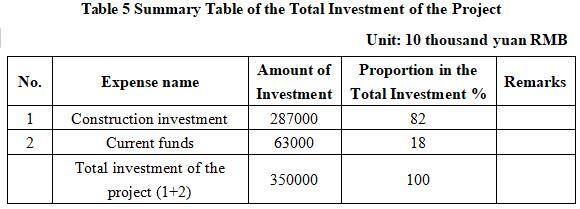
1.3.2 Capital raising
Raised by the enterprise itself.
1.4 Financial analysis and social evaluation
1.4.1 Main financial indexes
After the project reaches the production capacity, its annual sales revenue will be 6,730.76 million yuan, its profit will be 841.34 million yuan, its investment payback period will be 7.2 years (after the tax, including the construction period of 2 years) and its return on investment will be 24%.
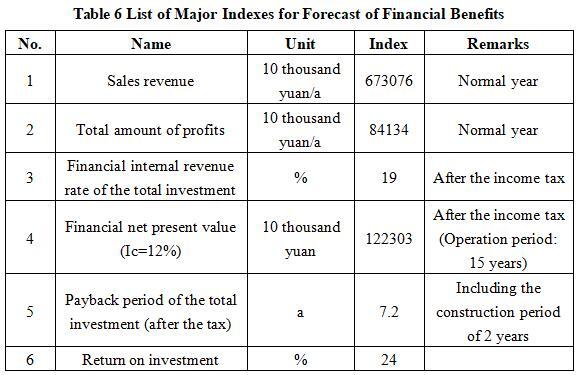
Note: “10 thousand yuan” in the table is in RMB
1.4.2 Social evaluation
This project will assist in the construction of a “clean, low-carbon, safe and efficient” energy system in Jilin Province, promote the achievement of the “carbon peaking and carbon neutrality” goals, and promote the harmonious development of the economy, society and ecological environment. It will support innovation and breakthroughs in new energy, new materials, and new technologies, and is expected to cultivate more emerging industries and promote the transformation and upgrading of traditional industries. Development of the project development will also strengthen the collaborative cooperation between different regions within the province, forming a multi-cluster and full-industrial-chain supported development pattern, and promote balanced regional economic development.
1.5 Cooperative way
Joint venture or cooperation, other ways can be discussed in person.
1.6 What to be invested by the foreign party
Funds, other ways can be discussed in person.
1.7 Construction site of the project
Longtan Economic Development Zone, Jilin City, Jilin Province.
1.8 Progress of the project
It is in planning phase.
2. Introduction to the Partner
2.1 Basic information
Name: Jilin Longtan Economic Development Zone Management Committee
Address: Longtan Economic Development Zone, Jilin City
2.2 Overview
Longtan Economic Development Zone is located in the northern part of Jilin City, within the boundaries of Longtan District. It is an important support area for the Changjitu Development and Opening Up Pilot Area and the Changchun-Jilin integration strategy. In April 2020, with the approval of the provincial government, Longtan Economic Development Zone was designated as a provincial-level development zone. The total planned area of the development zone is 12.65 square kilometers, with metallurgy, chemical industry, new materials, and high-end equipment manufacturing as the leading industries. In 2023, the total industrial output value of the development zone reached 19.1 billion yuan.
2.3 Contact method
Postal code: 132000
Contact person: Yu Xueming
Tel: +86-13704316345
E-mail: 804196585@qq.com
Contact method of the city (prefecture) where the project is located:
Contact unit: Investment Promotion Service Center, Bureau of Commerce of Jilin City
Contact person: Jiang Yuxiu
Tel: +86-432-62049694
+86-15804325460
E-mail: jlstzcjfwzx@163.com


